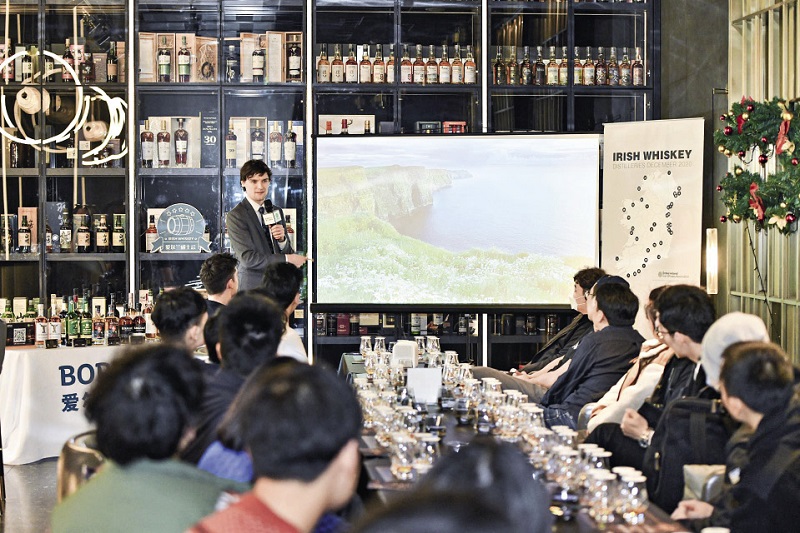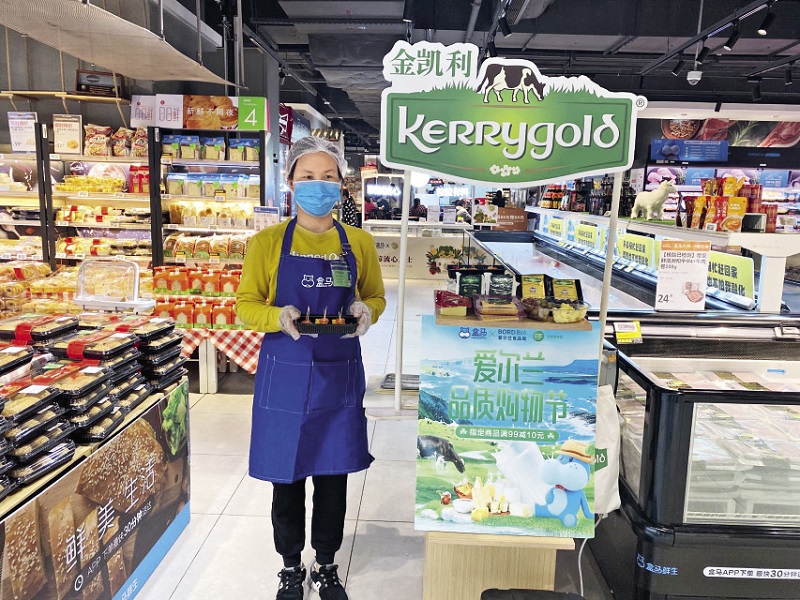China’s extraordinary development, which has shaped the world’s largest middle class, its modernization of foodservice and retail sectors, upgraded infrastructure, and broadening market access to foreign products, has made Irish food and drink exports to China more than quadrupled in the past decade.

The Ireland pavilion at the second China International Consumer Products Expo held in July 2022 in Haikou, south China’s Hainan Province.
My first impressions of China, as an exchange student at Shanghai University in 2011, were of the city’s vibrancy and the overwhelming potential of the country as a whole. Upon my return after graduation, over the ensuing decade spent promoting Irish exports to China I witnessed first-hand the country’s spectacular changes, and its evolution into one of the Irish food and drink industry’s most important markets.
In 2011, Irish food and drink exports to China were worth €169 million. Initially concentrated in a few core opportunities — primarily infant formula and pork, the potential of Ireland’s agri-food trade in China was nevertheless obvious.
The year 2012, saw the then Vice President Xi Jinping’s visit to Ireland in the course of several high-level engagements, which proved to be the catalyst for Ireland’s deeper relationship with China. Heightened cooperation in agri-food trade was a key item on Xi’s agenda. Two months later, Ireland’s then Prime Minister Enda Kenny visited Beijing and signed a range of cooperation agreements to strengthen bilateral trade and relations.
That same year, Bord Bia, the Irish government’s food promotion agency, opened the Irish Food Hub in Shanghai. More than just an expansion of Bord Bia’s presence to China, the Irish Food Hub doubled as an incubator for Irish companies entering the Chinese market. Since its inception the Hub has served as a launching pad for numerous Irish dairy, meat, beverages, and seafood operations in China.
By the end of the decade, Irish food and drink exports to China had more than quadrupled to over €900 million. Today, as one of Ireland’s most important food and drink partners worldwide, China constitutes a top priority destination. Bord Bia has substantially increased its activity in China, helping to consolidate Ireland’s reputation as a world-class supplier of sustainably produced food and drink.
Several factors have driven Irish exports of foodstuffs and beverages to China.

China Manager of Bord Bia (Irish Food Board) Conor O’Sullivan gives a masterclass about Irish whiskey at a bar in Shanghai in December 2021.
China’s extraordinary development over the past decade is well documented, especially the expansion of its middle class to become the world’s largest. This social phenomenon has significantly pushed China’s demand for a wider range of premium Irish food and drink. Rising incomes have generated a greater consumer demand for higher quality, more functional, and healthier food and food ingredients. Ireland has been well placed to meet these trends.
Historically, China’s highly fragmented food service and retail sectors made it difficult for many overseas companies to be part of the supply chain. China’s modernization of these sectors in recent years, however, has led the world. The growth of premium domestically-grown and foreign supermarket brands and, more recently, the emergence of technology-driven e-commerce and new retail have presented Irish suppliers with a stable route to the market. The gradual phasing out of local wet markets, meanwhile, has bolstered the retail sector as a channel for imported chilled and frozen goods. From a regulatory perspective, cross-border e-commerce has enabled smaller foreign brands to become established and flourish in China, and also protected consumers and companies alike from counterfeits and grey imports.
Similar changes are apparent in the food service sector. China’s embrace of a globalized diet has created a market for food ingredients from around the world. Concurrently, the remarkable innovation pace of China’s restaurant sector has given rise to new use-cases for ingredients. Examples include modern interpretations of hot-pot that have vitalized and highlighted previously underappreciated meat cuts, as well as undreamed of cheese applications, from cheese-top milk teas to cheddar ice cream. Food service brands have also expanded beyond the confines of restaurants through home delivery and ready-to-eat meals. Working closely with partners in China has enabled the Irish food industry both to adapt to these new ways of doing business and to ensure it can meet Chinese consumers’ specific needs.
Infrastructure development is an often understated yet critical element of China’s success story. The country’s investment in its airports, seaports, and cold-chain logistics in particular, has made the import of fresh, chilled, and frozen food that is accessible to consumers throughout the country both physically possible and financially viable. It has moreover opened up entire population centers as new market opportunities. Ireland’s seafood industry can now airfreight live Irish oysters and blue lobsters out of Ireland in pristine condition and ready to serve the next day at Shanghai’s finest restaurants.
China’s willingness over the last decade to broaden market access to more food sectors and food producers has been critical. But there are still untapped segments for Ireland. We eagerly await both the resumption of Irish beef exports and the start of Irish mutton exports in the near future. As a world leading producer of naturally nutritious grass-fed beef and lamb, Ireland offers a unique proposition that resonates strongly with the more health conscious and environmentally responsible Chinese consumers.
The signing of the EU-China Agreement on Geographical Indications, which came into force in March 2021, was another milestone. The agreement included two Irish products: Irish whiskey and Irish cream liqueur. Recognizing and protecting the distinctive production methods of Irish whiskey and cream liqueur have contributed to the quadrupling of Irish drinks exports to China in the last three years.
The launches of import-focused fairs, such as the China International Import Expo in Shanghai and, more recently, the China International Consumer Products Expo in Hainan, have created excellent platforms for foreign brands to raise their profile in China. In Hainan, the move towards a free-trade zone is another exciting development, embodying China’s drive to open up to ever more high-value trade opportunities.

Bord Bia joins hands with the store-chain Hema, promoting Irish food in 16 outlets of Hema in Guangzhou in November 2021.
Irish pork exports present a good example of how these changes have influenced the blending-in of Irish food in China. A decade ago, the bulk of Irish pork sold in China consisted of commodity cuts primarily to fill a gap in domestic supply, and distributed through a network of wholesale markets for further processing. The model in those early days offered scant opportunity to add value, or build a brand. Over time, however, the balance of exports has transformed. Although the commodity trade remains, higher value cuts now make up the majority of Irish pork available. This is attributable to Ireland’s having distinguished itself through promoting rarer breeds such as Hampshire pork, renowned for being both lean and tender.
As for dairy, Ireland has firmly established its reputation over the past decade as a leading producer of premium infant formula and advanced infant formula grade ingredients. Looking to the future, the market for high value Irish dairy is broadening. Chinese companies are investing substantially in developing products within such highly functional categories as adult nutrition, sports nutrition, and food for special medical purposes. Meanwhile, Irish dairy processors are working closely with their Chinese partners in the research and development of innovative applications tailored to the unique needs of these different segments. Bakery is another exciting area. The surge of high-end, widely diverse bakery manufacturers and retailers has created immense opportunity for Irish cream, milk, butter, cheddar, and mozzarella. In the retail sector, too, more and more Irish dairy can be found both online and offline, and Irish whiskey, gin, and cream liqueur are burgeoning as China’s bar industry grows more sophisticated. Seafood, particularly shellfish, continues to expand into the country’s diverse foodservice industry.
As the world moves toward a more sustainable future for food consumption, Ireland’s food and drink industry works in harmony with nature to produce more nutritious food while reducing human impact on the environment. These values align strongly with China’s development, so we are confident of an ever more fruitful coming decade of Sino-Irish agri-food trade.
CONOR O’SULLIVAN is the China manager of Bord Bia (Irish Food Board).